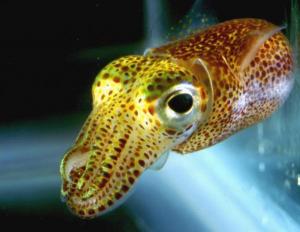By Kaine Korzekwa
CHICAGO — The Hawaiian Bobtail Squid isn’t afraid of the dark — but it still uses a nightlight. The nocturnal squid takes in light-emitting bacteria to perfectly match the moonlight or starlight coming from above, which allows it to avoid casting a shadow in the water column and elude predators.Margaret McFall-Ngai, a professor at the University of Wisconsin-Madison, discussed this squid’s relationship with the Vibrio fischeri bacteria during a Feb. 15 symposium at the American Association for the Advancement of Science meeting in Chicago.
“This anti-predatory strategy is actually very common in [open water] marine environments where there is nowhere to hide,” McFall-Ngai said. “These squid emit light of the same intensity, color and angular distribution as the light coming from above as a sort of cloaking device.”
The bacteria colonize a special light organ on the underside of the squid, which grow to only about 30 millimeters (slightly larger than an inch). The squid use the emitted light to provide what is called counter-illumination.
Because the light organ is located in the ink sac, the squid are able to adjust almost immediately to the emission of light by using structures in the ink sac to swiftly change the amount of light that escapes.
“So you can imagine the moon goes behind a cloud and the light dims,” McFall-Ngai said. “They are able to respond to changes like this very, very quickly.”
Emitting light is energetically costly for the bacteria, the light being the result of reactions from enzymes, she said. So McFall-Ngai and her team wondered why the bacteria haven’t evolved to simply colonize the squid but not emit light.
It turns out that the squid is able to tell if there are “cheaters,” bacteria taking up residence in them but not helping out by emitting light.
“The animal actually knows when the [bacteria] are making light,” she said. “It turns out that the animal actually expels cheaters, so next we wanted to see what happens when you colonize the animal with mutant bacteria that don’t make light.”
In a series of studies, the researchers found that the animal knows if the bacteria are doing their job. When colonized with a mixture of half light-emitting bacteria and half dark bacteria, the dark mutants began being lost within 48 hours and were undetectable after a few days, McFall-Ngai said.
“The animal says ‘someone isn’t doing their job, you’re gone,’ ” she added. “The squid can definitely tell that something is happening and that the bacteria are not quite right.”
McFall-Ngai next looked for the structure that allows the squid to detect and process if the bacteria are emitting light.
The light organ seems to have similar characteristics to the eyes of mammals, a process known as convergent evolution, McFall-Ngai said.
“We found that it is morphologically, genetically and biochemically convergent with the eye and that the tissue of the light organ can respond to light,” she said.
Her lab’s research into gene expression shows that the mammalian eye and the light organ may be using the same set of genes in development.
“This interaction includes just one host and one microbe, allowing us to easily examine how the two organisms respond to each other,” McFall-Ngai said. “We use the squid-vibrio pair to study the broad relationships between hosts and beneficial microbes.”
Kaine Korzekwa is a senior at The University of Texas at Austin majoring in both biology and journalism. He is currently the science writing/communications intern in UT’s College of Natural Sciences Office of Communications and the social media coordinator for UT’s Energy Institute. Follow him on Twitter @KaineK and see his website at kainekorzekwa.com.




